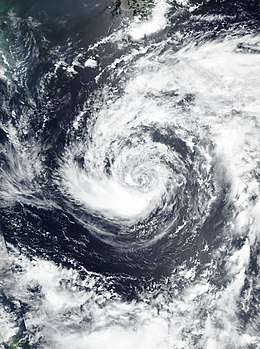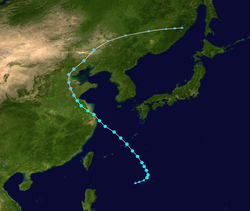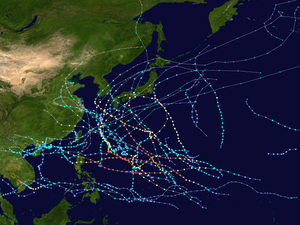Tropical Storm Ampil
Severe Tropical Storm Ampil, known in the Philippines as Severe Tropical Storm Inday, was a tropical cyclone that caused moderate damage in the Ryukyu Islands and East China in late July 2018. The tenth named storm of the annual typhoon season, Ampil developed into a tropical depression east of Luzon on July 17. The storm gradually strengthened in the following days, and achieved its peak intensity late on July 19. Maintaining peak strength, Ampil passed through the Okinawa Island late on July 20. After that, Ampil began to slowly weaken, as environmental conditions became less favourable. Ampil made landfall in Shanghai on July 22, before becoming extratropical two days later.
| Severe tropical storm (JMA scale) | |
|---|---|
| Tropical storm (SSHWS) | |
 Severe Tropical Storm Ampil approaching the Ryukyu Islands on July 20 | |
| Formed | July 17, 2018 |
| Dissipated | July 26, 2018 |
| (Extratropical after July 25) | |
| Highest winds | 10-minute sustained: 95 km/h (60 mph) 1-minute sustained: 100 km/h (65 mph) |
| Lowest pressure | 985 hPa (mbar); 29.09 inHg |
| Fatalities | 1 total |
| Damage | $241 million (2018 USD) |
| Areas affected | Ryukyu Islands, China, Russian Far East |
| Part of the 2018 Pacific typhoon season | |
Meteorological history

On July 17, the Japan Meteorological Agency (JMA) began to monitor a tropical depression over the Philippine Sea. The Joint Typhoon Warning Center (JTWC) designated it as 12W later that day. The depression initially moved westwards,[1] and turned to east-northeast on the next day, carried by monsoon westerlies. The system gradually organised under low wind shear, warm sea surface temperature of 29–30 °C (84–86 °F), and good equatorward outflow.[2] On the same day, the JMA said that the system has strengthened to a tropical storm, and received the international name Ampil.[3] The JTWC followed suit later.[4] At that time, Ampil had an asymmetrical structure. Its deep convection and the banding features were located south of the center,[5] and the low-level circulation center (LLCC) was partially exposed.[6] Late on July 19, Ampil began to turn northward,[7] and then northwestward, under the influence of a subtropical ridge to the south. The storm also slightly strengthened under marginally favourable environment. The LLCC was wrapped by curved convection.[8] Because of this, the JMA upgraded it to a severe tropical storm, and Ampil simultaneously achieved its peak intensity, with maximum sustained winds of 95 km/h (60 mph) and a minimum barometric pressure of 985 hPa (29.09 inHg).[9] Late on July 20, Ampil passed directly over the Okinawa Island, near Nago, while maintaining its peak strength.[10]
After passing Okinawa Island, Ampil began to slowly weaken, due to limited ocean heat content, while continued to move northwestward.[11] Its LLCC became partially exposed again,[12] and most of the convection were located at the northern part of Ampil.[13] The JMA reported that Ampil had weakened to a tropical storm early on July 22.[14] At 12:30 p.m. CST (04:30 UTC), Ampil made landfall in Chongming Island, Shanghai.[15] Upon doing so, Ampil became the eleventh tropical cyclone that made landfall in Shanghai, and the third tropical cyclone that directly struck Shanghai, without making landfall in other places.[16] Despite moving inland, Ampil's weakening trend remained slow. The JMA downgraded Ampil to a tropical depression on the next day,[14] and the JTWC issued the final advisory to Ampil later that day.[17] However, the JMA continued to track the system, and Ampil turned to northeast on July 24. The depression transited into an extratropical cyclone early on July 25, while located over Northeast China. The extratropical remnants of Ampil ultimately dissipated on July 26, over Primorsky Krai.[14]
Preparations and impact

Ryukyu Islands
On July 20, the Japan Meteorological Agency issued a storm warning (Japanese: 暴風警報) to Okinawa Island.[18] The warning was cancelled on the next day, after Ampil passed through the island.[19] Kitadaitōjima recorded wind gusts of 113 km/h (70 mph).[20] A total of 106 fights and 112 ships were cancelled on July 20–21, which affected almost 15,000 people.[21] 29 people were evacuated in Okinawa Prefecture.[22]
China
In advance of Ampil, more than 190,000 people in Shanghai were evacuated.[23] Wind speed in Jigu Jiao (Chinese: 鸡骨礁) reached 33.1 m/s (119 km/h), while rainfall in Hengsha Island were amounted to 112.8 mm (4.44 in).[24] As Ampil kept tracking northeastward, it affected Jiangsu and Shandong. Rainfall in Yancheng and Ju County reached 195 mm (7.7 in) and 211.6 mm (8.33 in) respectively.[25][26] Throughout the country, Ampil killed a person and the damage were amounted to be ¥1.63 billion (US$241 million).[27]
References
- "Prognostic Reasoning for Tropical Depression 12W (Twelve) Warning NR 01". Joint Typhoon Warning Center. July 17, 2018. Archived from the original on July 9, 2018. Retrieved July 18, 2018.
- "Prognostic Reasoning for Tropical Depression 12W (Twelve) Warning NR 03". Joint Typhoon Warning Center. July 18, 2018. Archived from the original on July 9, 2018. Retrieved July 19, 2018.
- "RSMC Tropical Cyclone Advisory Name TS 1810 Ampil (1810) Upgraded from TD". Japan Meteorological Agency. July 18, 2018. Archived from the original on October 13, 2016. Retrieved July 19, 2018.
- "Prognostic Reasoning for Tropical Storm 12W (Ampil) Warning NR 04". Joint Typhoon Warning Center. July 18, 2018. Archived from the original on July 9, 2018. Retrieved July 19, 2018.
- "Prognostic Reasoning for Tropical Storm 12W (Ampil) Warning NR 05". Joint Typhoon Warning Center. July 18, 2018. Archived from the original on July 9, 2018. Retrieved July 19, 2018.
- "Prognostic Reasoning for Tropical Storm 12W (Ampil) Warning NR 06". Joint Typhoon Warning Center. July 19, 2018. Archived from the original on July 9, 2018. Retrieved July 19, 2018.
- "Prognostic Reasoning for Tropical Storm 12W (Ampil) Warning NR 09". Joint Typhoon Warning Center. July 19, 2018. Archived from the original on July 9, 2018. Retrieved July 20, 2018.
- "Prognostic Reasoning for Tropical Storm 12W (Ampil) Warning NR 11". Joint Typhoon Warning Center. July 20, 2018. Archived from the original on July 9, 2018. Retrieved July 20, 2018.
- "RSMC Tropical Cyclone Advisory Name STS 1810 Ampil (1810) Upgraded from TS". Japan Meteorological Agency. July 19, 2018. Archived from the original on October 13, 2016. Retrieved July 20, 2018.
- 台風10号 沖縄本島北部を通過 吹き返しの暴風に注意 (in Japanese). Weather News. July 21, 2018. Retrieved July 22, 2018.
- "Prognostic Reasoning for Tropical Storm 12W (Ampil) Warning NR 13". Joint Typhoon Warning Center. July 20, 2018. Archived from the original on July 9, 2018. Retrieved July 21, 2018.
- "Prognostic Reasoning for Tropical Storm 12W (Ampil) Warning NR 15". Joint Typhoon Warning Center. July 21, 2018. Archived from the original on July 9, 2018. Retrieved July 21, 2018.
- "Prognostic Reasoning for Tropical Storm 12W (Ampil) Warning NR 16". Joint Typhoon Warning Center. July 21, 2018. Archived from the original on July 9, 2018. Retrieved July 22, 2018.
- "Digital Typhoon: Typhoon 201810 (AMPIL) - Detailed Track Information". Digital Typhoon. September 4, 2018. Retrieved December 22, 2018.
- Liu, Shuqiao (July 22, 2018). "Typhoon Ampil made landfall at the coastal regions of Chongming Island, Shanghai". China Meteorological Administration. Retrieved July 23, 2018.
- He, Qi (July 23, 2018). "Shanghai returns to normal in wake of Typhoon Ampil". China Daily. Retrieved July 24, 2018.
- "Tropical Cyclone Final Warning". Joint Typhoon Warning Center. July 23, 2018. Archived from the original on January 8, 2019. Retrieved July 24, 2018.
- 台風10号:今夕にも暴風警報発表 沖縄本島を直撃へ (in Japanese). Okinawa Times. July 20, 2018. Retrieved July 21, 2018.
- 台風10号:本島北部の暴風警報を解除 (in Japanese). Okinawa Times. July 21, 2018. Retrieved July 23, 2018.
- 台風10号、沖縄本島を通過 土砂災害や高波に警戒 (in Japanese). The Nikkei. July 21, 2018. Retrieved July 23, 2018.
- 台風10号:航空機92便が欠航決定 那覇空港発着、1万3千人に影響 (in Japanese). Okinawa Times. July 21, 2018. Retrieved July 23, 2018.
- 台風10号:沖縄県内で29人が避難 大半の避難所が閉鎖 (in Japanese). Okinawa Times. July 21, 2018. Retrieved July 23, 2018.
- 台风“安比”预计今中午登上海 已撤离安置逾19万人 (in Chinese). China Times. July 22, 2018. Retrieved July 23, 2018.
- 刘辉 (July 22, 2018). 截至16时,宝山79.2毫米降雨量为上海各区最大 (in Chinese). East Day. Retrieved July 23, 2018.
- “安比”裹挟暴雨将入山东 热带低压影响琼粤桂 (in Chinese). China Meteorological Administration. July 23, 2018. Retrieved July 25, 2018.
- 张玛睿 (July 23, 2018). “安比”来了!山东24个区县平均降水量超50毫米,2座水库超汛限水位 (in Chinese). 大众网. Retrieved July 25, 2018.
- CMA (December 4, 2018). Member Report: China (PDF). ESCAP/WMO Typhoon Committee. ESCAP/WMO Typhoon Committee. pp. 1–2. Archived from the original (PDF) on December 4, 2018. Retrieved December 4, 2018.
External links
| Wikimedia Commons has media related to Severe Tropical Storm Ampil (2018). |
- JMA General Information of Severe Tropical Storm Ampil (1810) from Digital Typhoon
- JMA Best Track Data of Severe Tropical Storm Ampil (1810) (in Japanese)
- 12W.AMPIL from the U.S. Naval Research Laboratory
